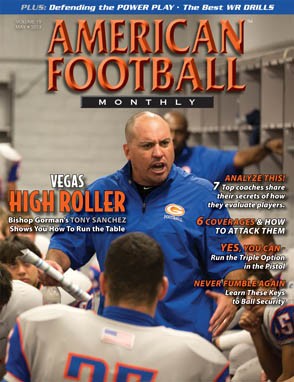AFM Subscribers Ask -with Curtis Tsuruda Strength and Conditioning Coach, East St. John High School (LA)
by: AFM Editorial Staff©
More from this issue
Curtis Tsuruda has over 30 years of experience as a strength and conditioning coach. He has worked at Tulane, LSU, Hawaii and Mississippi State. Tsuruda is currently the strength and conditioning coach at East St. John High School in Reserve, Louisiana. He holds the distinction of being a Master Strength and Conditioning Coach, the highest honor in his profession and was selected in 2010 as Samson Equipment’s National High School Strength and Conditioning Coach of the Year. He answers your questions.
What is your philosophy and schedule (days of the week) for in-season workouts and how do you use that to build strength and endurance? Ron Cook, Defensive Coordinator, Lumberton High School (NC).
Philosophy: We are training for post-season play, but everything is based upon what we have done since the last football game. You must constantly evaluate your plan.
Schedule: Sit down with the head coach and see what his daily plan looks like. You don’t want to burn the players out. Three times a week is what I like to use.
Day 1- Heavy upper body (Monday)
Day 2 – Heavy lower body (Tuesday)
Day 3 – Shoulder day (Wednesday)
Day after the game – flush workout – total body (Saturday)
We use a mini four-week cycle and repeat it as the season goes on. All Olympic movements are based on speed and technique. For endurance, you can use a drop set after the last working set.
What is your feeling on lifting/speed agility training on game day for the high school player? Bryan Gray, Head Coach, East Hall HS (GA).
We don’t do it because you run into a logistics problem. If you have a home game, you can, but if on the road, it is very difficult. It may become a psychological problem when you don’t so I wouldn’t advise it. Always remember, “If you are over trained, you will have nothing left in the tank.”
What are your ‘must’ movements for training pre-season and in-season? Steve Walsh, Assistant Coach, St. Thomas Middle School, Glen Mills (PA).
Here is my list in no particular order:
• Dynamic movement warm ups
• Flexibility
• Hip mobility
• Hamstring, hamstring, hamstring
• Total body movements
• Ground-based exercises
• Shoulders, traps, and neck
My questions pertain to off-season conditioning for a college D-III program. With the non-contact for coaches in the off-season, what are some motivational tactics that you’ve found to be successful to keep athletes consistently in the weight room? What is the right balance of Speed-Agility-Quickness work and strength training? How can we position it better to help linemen focus more of their off-season on SAQ? Jud Keim, Assistant Head Coach, Pacific Lutheran University.
A. Motivational tactics: quotes that we use with our players:
“Whatever you don’t do, it’s not hurting me,
but your future”.
“Your opponents are working out also”.
“Research shows a decrease in strength levels varies from 7-14 days”.
“You can never be in good enough shape”.
B. SAQ work and strength training:
1. What are the needs of the team or positions or athlete specific needs?
2. It is human nature to gravitate to what you’re good at. Lifters like to lift and not condition while speed guys like to run, but are not great in the weight room. You must have a balance of both. If you don’t, sooner or later you will be exposed. The player needs to be a well-rounded athlete.
C. Linemen: “You have to get there first”. The only way he can accomplish that on every play is to work on his SAQ.
With the popularity of the new cross fit workouts, is there relevance for this type of training with football preparation and injury prevention? Dan McLean, Head Coach. Detroit Country Day School (MI).
They break up the monotony of workouts, but the athlete needs to be prepared to make those types of movements. Yes, there is relevance, but the coach needs to choose exercises wisely. It is very easy to “rah, rah a player in the training room” without proper preparation and planning.
What is your feeling on low rep/high percentage workouts during the season? What are your thoughts on both kettle bell swings and the snatch during the season? Paul Walderzak, Head Coach, Standish-Sterling High School (MI).
What you do during the season is based upon what you’ve done leading up to it. Everything should be based on what and how practice will be for that day. Why do a 95% squat workout when you know you’re going to run 8 x 110s after a 2 ½ hour full pads hard hitting practice? Remember, you’re in high school. Save your hardest workouts for Friday night. Just ask yourself, “Are we training hard or smart?”
As for kettle bell swings, is it a core or auxiliary lift? If you do it, keep the volume down. We snatch during the season. p
What are some exercises that you have your athletes work on to improve hip, leg, and ankle flexibility when they have difficulty in doing a proper squat? Mike Williams, Head Coach, Manheim Central High School (PA).
Here are some exercises to improve doing proper squats:
• Hurdle exercises
• Going rock bottom or as deep as you can go with these three squats -
- Snatch or overhead squats
- Saigon squats
- Front squats
• Heel cord box and stretches
Lighten the load and always remember, “Never sacrifice technique for weight”.





